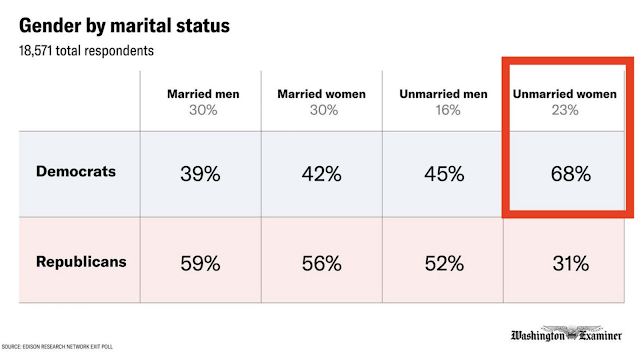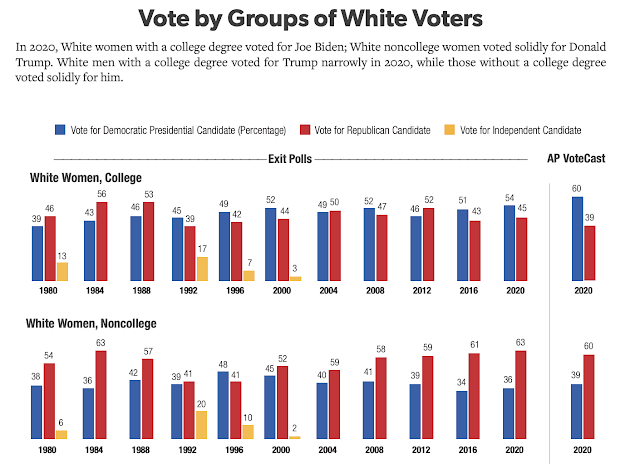One of the more interesting phenomenons in politics in the United States today is the gender divide.
There is a huge difference in the views of men and women when it comes to politics.
This gender divide was not present in the 1970's. It first appeared in the 1980 election when Ronald Reagan was elected.
Today, Women tend to be Democrats. Men tend to be Republicans.
For example, in 2016, Men favored Trump by 12 points. Women voted for Hillary by 12 points amounting to a 24 point gap.
The gap was 23 points when Biden was on the ballot in 2020.
The gender divide has widened in the last few years with Trump but it has been present for a long time.
In fact, there was a gender divide of 22 points with Bush-Gore in 2000, 17 points with Clinton-Dole and 18 points with Obama-Romney.
 |
| Source: https://www.aei.org/wp-content/uploads/2022/01/The-Exit-Polls.pdf?x85095 |
Most current polls show the gender divide continuing in 2024.
A Echelon Insights poll that was just released shows Trump with an overall 49%-48% edge but he is favored by Men 54%-44% while Women are supporting Harris by 52%-44%---an 18 point gap. The good news for Trump is that he is doing slightly better with both Men and Women in that poll than he did in 2020.
On the other hand, a New York Times/Siena poll that was conducted a week earlier in the swing states of Arizona, Georgia, Nevada and North Carolina that had Trump and Harris tied at 48%-48% shows an even larger gender divide.
In that poll, Trump is leading win Men by 55%-40%. Harris is favored by Women by 55%-41%---a gigantic 29 point gender gap.
You get a better sense of the gender gap when it is broken down by age.
This is a graphic from The New York Times on the gender gap by age from a similar battleground state poll it did in August matching Trump and Harris.
Men of all ages favor Trump. Women of all ages support Harris. However, the largest gender gap is in the age 18-29 age group----around 50 points.
 |
| Credit: https://x.com/ClayTravis/status/1827889880753439047/photo/1 |
The gender divide in the age 18-29 age group is clearly impacted by the number of single women in that demographic.
However, in many respects the gender divide is largely influenced by a much larger marriage gap that has existed over the years.
Those that are married---both men and women---vote Republican.
Women that are not married vote Democrat.
 |
| Source: https://www.aei.org/wp-content/uploads/2022/01/The-Exit-Polls.pdf?x85095 |
As I have pointed out in these pages before, this breakdown of voting by gender and and marital status puts the gender divide in sharp focus
 |
| Source: https://www.washingtonexaminer.com/opinion/1787170/no-one-benefits-more-from-the-destruction-of-the-american-family-than-the-democratic-party/ |
Undoubtedly, the abortion issue in the wake of the Supreme Court's reversal of Roe v. Wade has contributed to a widening gender gap.
That is apparent in the New York Times/Siena poll cited above.
Consider the different responses of Men and Women on what is the most important issue in 2024 that will determine their vote in that poll.
The most important issue for Men is the economy---27%.
The most important issue for Women is abortion---22%.
Of course, what is most interesting is putting all of this in context.
The Democrats have spent a lot of time over the last two years demonizing the U.S. Supreme Court due to its decision in overturning the Roe v. Wade decision on abortion.
The Democrats like to portray the decision as if abortion has been banned in the United States.
It should comes as little surprise that many believe that propaganda even though the decision merely placed the question of what the limits (if any) to abortion should be determined at a state level by the voters.
Last year a survey found that half of Americans thought overturning Roe v. Wade banned abortion nationally.
That view was held by 63% of Democrats. I wonder where they got that idea?
What is even more interesting is that while half of Americans seem to believe that the U.S. Supreme Court banned abortions in the United States, abortions in the United States have actually increased after Roe was overturned.
In fact, abortions in the first full year after Roe was overturned reached a decade plus high according to the Guttmacher Institute which is an abortion rights think tank.
 |
| Source: https://ny1.com/nyc/all-boroughs/health/2024/03/19/abortions-hit-12-year-high-in-first-full-year-after-roe-overturned |
In 2023, the first full year after the Supreme Court overturned Roe v. Wade, abortions within the formal U.S. health care system hit a 12-year high, according to data released Tuesday by the Guttmacher Institute, an abortion-rights policy think tank.
There were 1,026,690 abortions performed last year, a rate of 15.7 abortions per 1,000 women, according to the data. That is up from 930,160, or 10.4%, in 2020, the last previous year for which comprehensive data was available.
Medication abortion accounted for 63% of all abortions last year, up 10 percentage points from 2020.
It should be noted in the data above that almost two-thirds of abortions in the last year were medication abortions many of which involved the use of the drug "mifepristone".
Abortion opponents recently sought to have the Supreme Court revoke the FDA's approval of mifepristone. This drug has been available for over 20 years with FDA approval and has been used in over 6 million abortions over that time.
However, there has been little attention by Democrats or the mainstream media to the fact that the same Supreme Court that overruled Roe also UNANIMOUSLY rejected a challenge to the FDA's approval of mifepristone in a decision handed down in June.
Another interesting insight in the gender divide is the the huge difference in the political views of women who are college graduate vs. non-college graduates.
White women who are non-college graduates voted for Trump by a 63%-36% margin in 2020. White women who are college graduates supported Biden by 9 points. That is a 36 point gap. It is larger than the gender divide between men and women.
Do white women who are non-college grads care less about abortion or other issues important to women than college women?
 |
| Source: https://www.aei.org/wp-content/uploads/2022/01/The-Exit-Polls.pdf?x85095 |
What can we make of all of this?
One of the greatest thinkers of our time was a man named Richard Feynman (1918-1988).
Feynman worked on the Manhattan project in his twenties and went on to win the Nobel Prize in Physics for his work in developing an understanding of quantum mechanics. He was on the Physics faculty at Caltech for much of his career
However, his method of thinking, which he applied to everything in life, is what made him standout as a unique human being. He took nothing for granted or at face value. He approached every problem or issue from the ground up.
The Feynman method of thought was developed by a man who refused conventional wisdom at all turns and who sought to build his mental computer from the ground up, starting with an understanding of mathematics at a very young age. (Feynman’s early notebooks are records of him deriving algebra, calculus, trigonometry, and various higher maths on his own, with original results and notation.)
This was how Feynman approached all knowledge: What can I know for sure, and how can I come to know it? It resulted in his famous quote, “You must not fool yourself, and you are the easiest person to fool.” Feynman believed it and practiced it in all of his intellectual work. (emphasis added)
Feynman also said this.
Age 18-29 year old women are better educated than they have ever been in the United States.
Women have outnumbered men in college degree programs by several million in each year for most of the last 20 years.
 https://www.statista.com/statistics/236360/undergraduate-enrollment-in-us-by-gender/
https://www.statista.com/statistics/236360/undergraduate-enrollment-in-us-by-gender/How do you explain the gender divide?
How do you explain the marriage divide?
How do you explain the college/non-college divide?
Those are tough questions.
However, the divides are real and are big reasons why we see the wide divisions we see in American politics today.
I offered some thoughts on the gender divide in a post earlier this year titled "Mars, Venus and Planet Earth" if you would like to take a deeper look at this issue and some possible explanations as to what underlies all of this. It might be worthwhile reading for additional context on this issue if you did not see it previously.





Enjoy BeeLine immensely. Today, you ask 3 questions at the end: "How do you explain...???"
ReplyDeleteWhenever you pose such questions I would submit perhaps ask one more. "How many Americans went to church last Sunday?"
Thank you Scott for your Feynman like analysis.
ReplyDelete